The shortage of experienced ophthalmic staff seems to be the bane of practices nationwide. Thanks to a combination of low unemployment rates and lack of awareness of the job, the pool of staff and experienced ophthalmic technicians is quite small. Lynn Anderson, PhD, CEO of the International Joint Commission on Allied Health Personnel in Ophthalmology (IJCAHPO), says, “The reason JCAHPO was started in 1969 was that there weren’t enough people in the profession to act as physician extenders. So there’s a long history of not having enough technicians.”
“All ophthalmologists are looking at the same short supply of people,” says Richard Jahnle, MD, FAAO, president of Jahnle Eye in Havertown, Pennsylvania, and founding partner and board member of the Crozer-Keystone Surgery Center in Haverford.
Today, the problem is nationwide in almost every field, Dr. Anderson says. With the current unemployment rate in the health-care industry at a low of 2.3 percent as of August 2019,1 job-seekers have their pick of employers. In the face of retirement, competing job offers and life changes, turnover among staff may seem inevitable. In this article, experts discuss the challenge of turnover and offer strategies for attracting and retaining good staff.
A Good Tech is Hard to Find
Erica Jahnle, the chief operating officer and practice administrator for Jahnle Eye, says it’s almost impossible to find experienced technicians. “There are a number of ophthalmic medical technician programs in this area. I know Camden County College and Philadelphia Community College have programs. But at least in this past year, to my understanding, they had very few students enrolled in those programs.”
While a degree isn’t necessary for a technician position, the educational experience is still very valuable. Ophthalmologists require highly specialized individuals to work with them. “It’s not like most medical practices where you can just hire medical assistants or a nurse practitioner or a physician assistant,” says Robert M. Kershner, MD, MS, FACS, professor and chairman of the Department of Ophthalmic Medical Technology at Palm Beach State College and president and CEO of Eye Laser Consulting Global in Palm Beach Gardens, Florida. “They don’t know the eyes or understand the terminology the way we do. The only one who understands the eye as well as we do is an optometrist, and obviously, hiring an optometrist is going to cost a lot more money.”
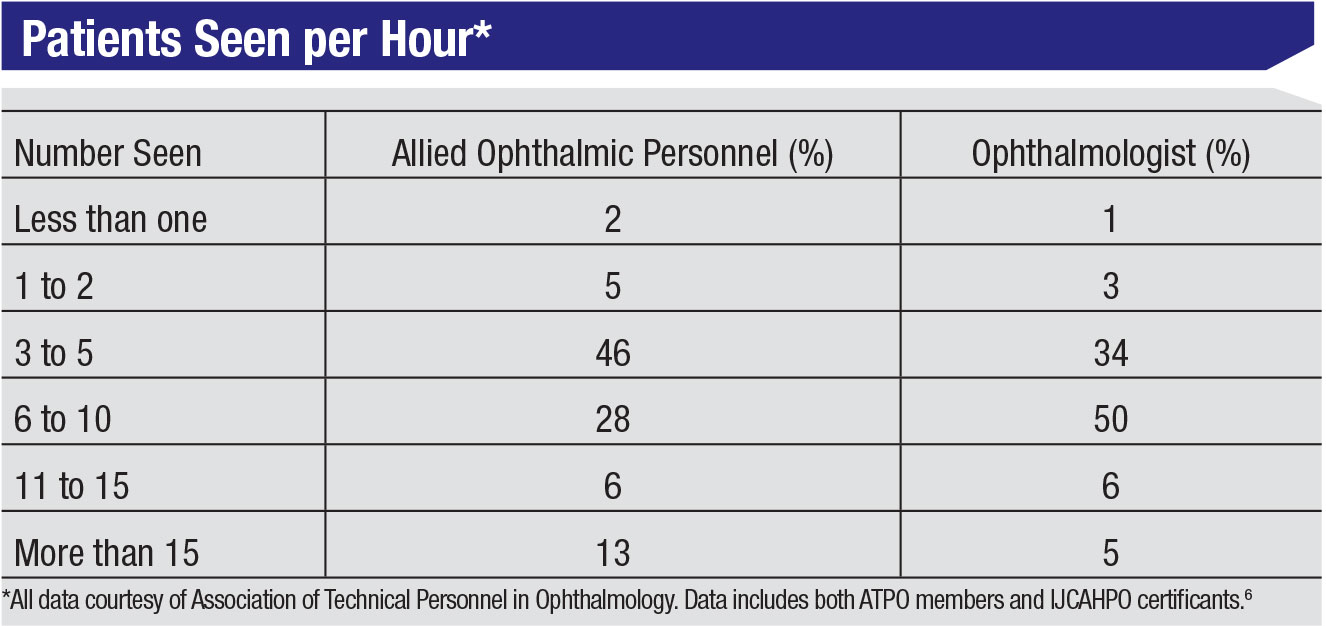 |
Most medical assistant programs train individuals in phlebotomy and taking blood pressure, but those skills aren’t applicable to an ophthalmology practice. “Historically, we’ve accepted undertrained individuals who, for the most part, required in-house training, which takes a lot of time out of our practice and time away from staff,” says Dr. Kershner.
He says ophthalmic training programs are the best-kept secret in the country. “There are only about 30 programs in the United States that are certified by the International Council of Accreditation for Allied Ophthalmic Education Programs that train people to become ophthalmic technicians or technologists.2 For certified ophthalmic technologists, there are only three accredited programs in the nation, including the one I established. That’s pretty sad. We’re obviously making a dent, but we can’t possibly train enough people to meet the need.”
Dr. Kershner’s program at Palm Beach State College launched in 2012. It offers an Associate of Science degree that includes two clinical rotations in dozens of externship sites. Typically, only 15 students are accepted each year. The Bascom Palmer Eye Institute usually hires most of the program graduates.
While the job outlook for technicians is good, that’s only because the supply of technicians lags far behind the demand. “The need for techs in this profession is significant, with medical assisting listed with a projected growth rate of 29 percent from 2016 to 2026,” says Dr. Anderson, citing the Bureau of Labor Statistics job outlook projection.3 The BLS considers this growth rate to be much faster than average for all occupations, due to the aging baby-boom population and the accompanying increase in demand for preventive medical services.3
Additionally, the 2019 update on the complexities of physician supply and demand and projected numbers from 2017 to 2032 for the Association of American Medical Colleges finds that there won’t be enough new doctors to care for the growing numbers of patients as the current generation of older doctors retires.4
“Every ophthalmologist I know is already working to get as many patients as they can to make ends meet, so they’re not going to be able to see even more patients or do much of anything else,” Dr. Kershner says. “They’ll need ophthalmic techs trained to do the entire exam so the doctor can just sign off on it. That frees the doctor to do what only the doctor can do, and that’s surgery and laser. We have an aging population and an increased demand for ophthalmic services. We need to have more personnel as physician extenders.”
Programs and Certification
Certification serves as a benchmark for competency, performance standards and up-to-date knowledge, according to IJCAHPO’s criteria for certification. Steven Dewey, MD, in practice at Colorado Springs Eye Clinic, says, “Our field is changing so rapidly. It’s difficult to stay on top of all of the advances and changes. We definitely prefer that techs be certified, and the pay scale reflects that. They get rewarded for their additional training and maintenance of certification.”
Likewise, degree programs offer consistency in preparation, explains Anthony R. Garand, executive director of the Bascom Palmer Eye Institute. “Too often in the practice setting, the demand of the daily workflow and the needs of the practice limit training and teaching capability. Also keep in mind that good technicians aren’t necessarily good teachers.”
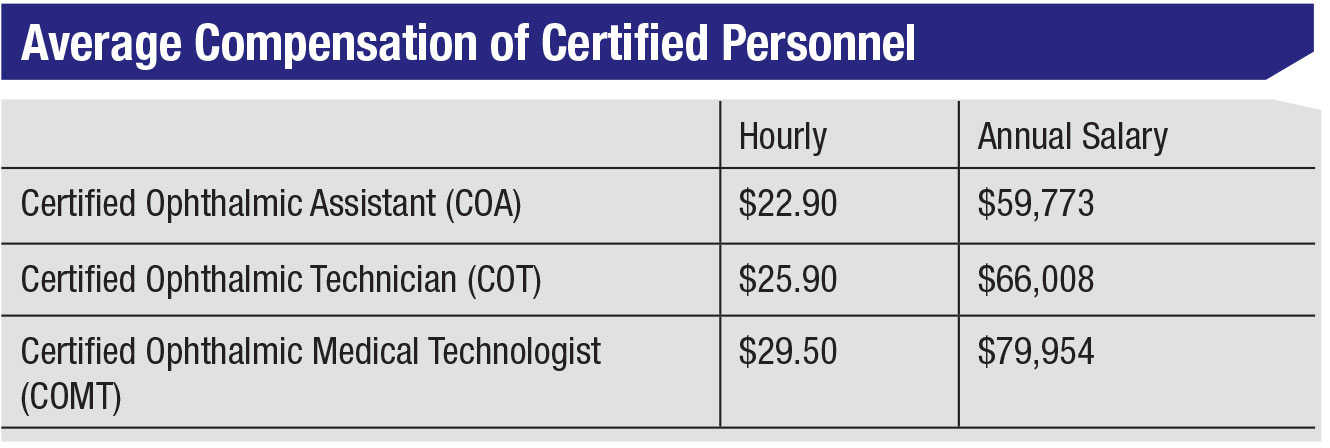 |
Furthermore, Mr. Garand notes that program-trained technicians tend to have a greater comfort level with testing and the certification process due to the academic nature of their training program, and they’re ready to take the certification exams earlier than in-house-trained technicians. He says, “The bottom line is that a certified technician has an advantage and is better prepared. Training on-site is time-consuming and not a guarantee of success. In-house training of staff requires significant internal motivation.”
IJCAHPO is the governing organization for continuing education and professional certification for ophthalmic medical personnel. Certification is examination-based and candidates must hold a high school diploma or the equivalent and have completed either an accredited formal clinical training program or some combination of accredited formal training program or independent home study and work experience.
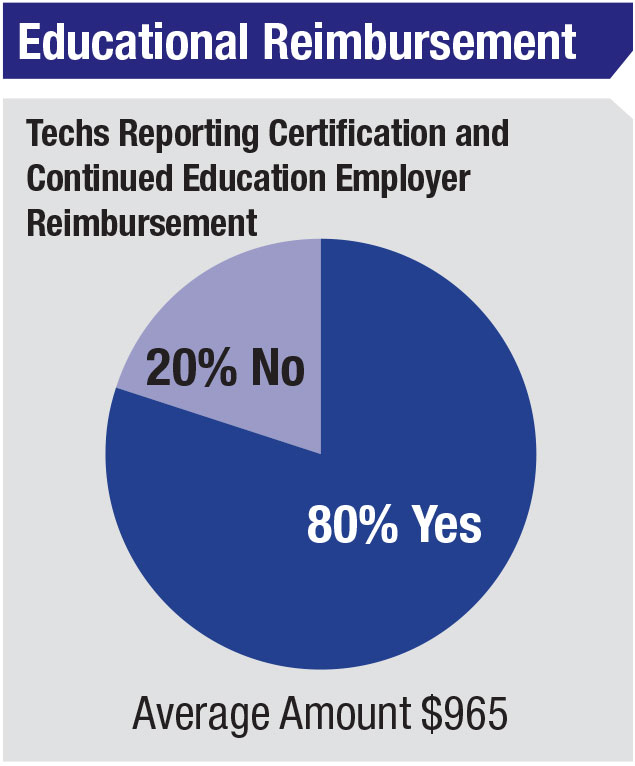 |
Ophthalmic credentials include Certified Ophthalmic Assistant (COA), Certified Ophthalmic Technician (COT) and Certified Ophthalmic Medical Technologist (COMT). COAs have basic, entry-level knowledge with about one year of study. COTs have more skills and can also train to take tonometry and measure refraction. The COMT is the highest level of certification, indicating that an individual has been trained on all equipment in the office, can oversee staff and can even assist the ophthalmologist in surgery. A 2008 comparative impact study found that, compared to noncertified personnel, the employment of certified ophthalmic medical personnel enhances and increases practice quality and productivity.5
“The ideal assistant for an ophthalmologist would be a certified ophthalmic medical technologist,” Dr. Kershner says. “My experience has been that once ophthalmic practices are introduced to highly-trained individuals and work with them, they can’t get enough.”
Encouraging certification benefits practices in the long run while offering technicians avenues for personal growth. “Certification justifies a higher salary and makes an employee more competitive for hiring,” observes Mr. Garand. The 2017 Salary Survey from the Association of Technical Personnel in Ophthalmology puts Certified Ophthalmic Assistants at around $21.09 an hour and non-certified at around $19.55 an hour.6 Gaining another level of certification can boost a technician’s annual salary by as much as $10,000.6
In-House Training
Most doctors agree that hiring certified ophthalmic staff is preferable to expending resources for training, but much of the time it’s just not possible. However, “Nobody’s telling you that you can’t hire technicians without certification, or that they can’t do x, y and z without certification,” says Becky Reitinger, president of Reitinger & Associates, an ophthalmic consulting firm in Eugene, Oregon.
Certain subspecialties, such as retina and oculoplastics, don’t need certification for some tasks, but instead can just be trained. Certification is geared more toward general ophthalmology and teaches skills like refracting.
For Dr. Dewey, a medical background is a must for prospective techs. His practice has hired certified medical assistants who didn’t know much about eyes but came with an interest in learning. He assisted with their training. “I don’t recall the last time we took somebody who had no medical background and trained them to become an ophthalmic tech,” he notes.
Dr. Jahnle says his practice’s training program is like an internship or an apprenticeship, where the new technicians learn on the job. Jahnle Eye’s clinical coordinator is JCAHPO-certified and is the main trainer for the new technicians. Additionally, a JCAHPO trainer comes to the office for a boot-camp-style training for the inexperienced hires. “This is kind of an extraordinary circumstance for us, because we hired two new doctors and had to hire a big group of technicians all at once,” says Ms. Jahnle. “This was a convenient way to add to their training.”
Dr. Kershner sees an advantage in having someone experienced with the eye. Though hiring a certified ophthalmic technician costs more than hiring an inexperienced person, Dr. Kershner says it’s less risky and worth the investment. He says an in-house-trained technician may leave your practice for someone who’s paying a dollar more per hour than you are, after you’ve invested time and money in their training and experience. If you hire a person with training and they leave to work elsewhere, you haven’t lost anything except the person. “For what you pay an ophthalmic tech, you can see a lot more patients and do a lot more,” he says. “A highly trained individual with their own skillset who doesn’t need supervision can make you a lot more money because they can do things to alleviate the burden on the doctor.”
The Challenge of Turnover
Turnover brings in new people and new energy, which can refresh a practice, says John Pinto, ophthalmic practice management consultant and president of J. Pinto & Associates in San Diego. But it’s costly. “We spend about thirty cents of every dollar we take in on staffing costs, so there’s a lot at stake,” he says. “Getting it right can make big, positive differences in profitability, and doing it poorly can really kill a practice’s financial performance. It’s really impossible to place too much importance on what you’re doing in this area.”
Too much turnover is disruptive to the practice, says Dr. Kershner. “Patients love to see the same person when they come each time. They obviously bond with your techs.”
Professional, qualified personnel are in high demand, and competing offers from private practices are strong draws, says Mr. Garand. Dr. Kershner adds that private practices generally have higher starting salaries, better hours, and more opportunities for growth and responsibility than hospitals.
Despite the state of staffing, Dr. Jahnle remains optimistic. Employees leave for plenty of other reasons besides money. Sometimes a job just isn’t the right fit. “At the beginning, we try to explain what the job’s going to be like, but they don’t know until they actually do it,” he says. “Occasionally we have people who work for a very short time and decide it’s not what they thought it was going to be, or it was too busy. But most people who stay on past the first few months end up staying for a while.” In some cases, techs just take the job temporarily on their way to more advanced schooling.
However, perhaps the biggest factor influencing turnover is job dissatisfaction. An internal IJCAHPO survey of technicians found that unhappiness with the employer was the number one reason for leaving a job. “A lot of doctors say, if I get them certified they’ll leave or if somebody offers one dollar more across the street they’ll leave,” says Dr. Anderson. “And you know, to some degree that’s true, but actually it’s more likely that they’re not happy working there anyway.”
Mr. Pinto identifies a diffuse feeling of low morale as the causative factor in job dissatisfaction. “The doctor’s respect for the staff can bring the morale level up to around seven or eight out of 10 points,” Mr. Pinto explains, citing a proprietary tool he and Corinne Wohl, MHSA, COE, ophthalmic practice management consultant and president of C. Wohl & Associates in San Diego, use to measure staff morale. “The most common reason for low morale, when you dig a little deeper and ask staff, is some aspect of doctor behavior.
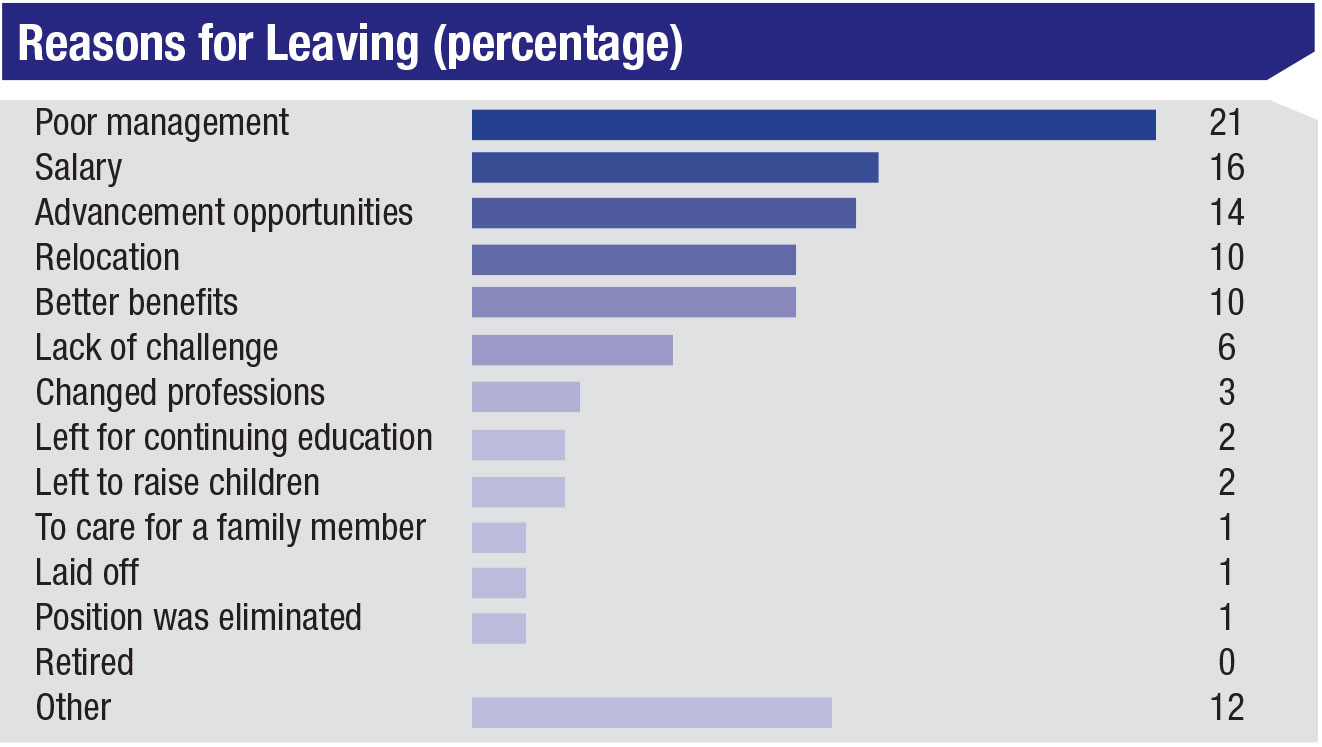 |
“This could range from ‘The doctor didn’t say hello to me in the morning when she came in,’ or ‘The doctor’s delayed in getting dictation off to me,’ all the way up to just frankly being rude and insecure or saying one thing and doing another or blowing staff off,” he says. In their experience, a low morale level often correlates with a high turnover rate.
“This doesn’t require bringing in muffins every Friday morning,” Mr. Pinto says. “What you don’t want to do is leave through the back door every evening and over your shoulder say, ‘Thanks, guys. It was a great day.’ Instead, throughout the course of the day, you want to catch people doing good things and cite them for that specifically and publicly.”
Ms. Wohl says adding workplace enjoyment or “formalizing fun” is key to raising staff morale. “Take time on a regular basis (at least monthly) to show appreciation for the staff and have some fun in the practice” she says. “A game of bingo, via email, or solving trivia quizzes are small ways to incorporate fun without impacting patient care.” Some other activities might include celebrating holidays, dressing up for Halloween—yes, even the doctor—or a barbecue. “Ultimately, we’re talking about teambuilding and showing that the practice cares and appreciates its employees. Anything you can do that puts a little break in the day that’s cheerful and positive for employees will help team spirit and get them engaged at a different level than being only work-focused.”
How to Find a Tech
Experts are noticing a trend in today’s technician job applicants that differs from technicians hired 20 or 30 years ago. “We have a lot of people here that have been with us for decades,” says Ms. Jahnle. “You can’t even measure how valuable that is for us. But it’s a different kind of applicant pool out there right now.”
In Mr. Garand’s experience at Bascom Palmer, “the newer employees tend to look at hourly salaries and short-term rather than long-term benefits.” Ms. Reitinger agrees, saying that “the younger generation doesn’t seem to want to commit to long-term jobs. They want a job for six months or a year, and most of the ophthalmology clients that I have say technicians are just learning their job by then. So that doesn’t really work out well for them.”
It’s important to know what today’s job applicants are looking for, as well as how they’re searching for jobs. Here are some pearls for finding good staff and keeping them in your practice.
• Consider the ‘what’s in it for me’ factor. That’s what candidates are looking for today, says Ms. Galasso. With the low unemployment rate and scarcity of technicians, it’s more important than ever for practices to make their job offers attractive. “Today, it’s all about ‘why should I not miss out on this employment opportunity?’” she says.
“Consider all of the things that attract any candidate in any market, which are incentives, competitive compensation and great perks,” Ms. Galasso continues. “If I’ve worked for a practice for 15 years and have five weeks of paid time off now, and you only offer two weeks, it’s going to be a tough sell for me. So you’re looking for all the ways you can market why it’s a great opportunity.”
“Talking about what the work environment is like, and having a lot of great, long-standing employees shows that your practice is a great place and people want to stay there,” says Ms. Reitinger. “Everyone in general is more focused on work environment today, not just this current generation.”
Health-care insurance is another important factor in a candidate’s decision to change jobs, explains Ms.
Galasso. “They’ll always want to know what their monthly out-of-pocket expense will be relative to what they have now,” she says. “Candidates who’ve been somewhere for five or more years likely have health-care insurance that works for them, a retirement plan or profit sharing, level-up paid time off, and other perks that come with tenure—some type of investment in them as a long-term employee.”
“If it’s been a long time since your practice has performed a local market salary survey, it’s worth the effort,” says Ms. Wohl. “You want to be offering fair and competitive wages in order to attract qualified, talented staff.”
• Determine your applicant’s goals. Ms. Galasso says a 10-minute phone interview to prequalify candidates will save you time. Ask what they’re looking for in an employer or when they’d be available to start. If their goals don’t match what you can offer, don’t waste your time.
• Market your practice. The general marketing of your practice also impacts your HR, explains Ms. Reitinger. If your practice is perceived as a really cool place to work or has a strong reputation among staff people, then people will be more excited to apply. Consider putting a “Careers” section on your practice website.
• Keep online job postings short. Ms. Galasso says it’s important to have attention-grabbing headlines that are easy to understand. “Differentiate your ad with a catchy introduction, something that looks a bit different from everyone else’s,” she advises. Job applicants will skip a wall of text, so Ms. Galasso no longer advocates adding full job descriptions in the posting. “Use bullet points for listing key core competencies that someone would need to fulfill the role, then provide a job description when you decide to interview them,” Ms. Galasso explains. “Most people are able to do their job effectively because they have skills, but moreover because they have core competencies that are both foundational and scalable.”
• Initiate contact within 48 hours. The low unemployment rate means your applicant is likely talking to multiple prospective employers. Connecting with the candidate right away is important. Ms. Galasso recommends a 48-hour window, either by email or phone. You don’t have to hire that first person, she says, but if you wait for another week, you’re going to lose that candidate.
• Don’t hire too fast. While it’s important to make that initial contact, take your time and make sure the candidate is a good fit. Ms. Reitinger notes that in this environment, practices feel pressured to hire right away. “You’ve got to know this is a good fit, because firing or dealing with a difficult employee is much more painful than not having one,” she says.
• Try shadowing. This allows the candidate to get to know the practice in an informal environment and see if it’s a good fit for them. It also gives your current employees a chance to get to know their prospective colleagues, says Ms. Reitinger.
• Have multiple staff members interview the finalists. “It can be a serious mistake for just the office manager to interview a candidate, hire them on the spot, and then introduce them to the colleagues they’re going to be working with the next week,” says Mr. Pinto. “It’s important, for example, if you’re hiring a prospective new tech, that all the techs in the department have a chance to meet that finalist before the hirers make the decision.”
• Look for personality. “It’s worth it to hire someone with a good personality,” says Ms. Jahnle. “We can always teach them the technical skills, but it’s much harder to teach someone to be patient and kind.”
• Look for adaptability. The medical field changes rapidly, and adaptability is especially important in the case of office staff, notes Ms. Jahnle. “The codes we use are changing,” she says. “Medicare fees are changing. Electronic medical records are changing. So candidates have to be very open to change and learning new things all the time. I think if they’re not comfortable with that, it’s probably not a good role for them.”
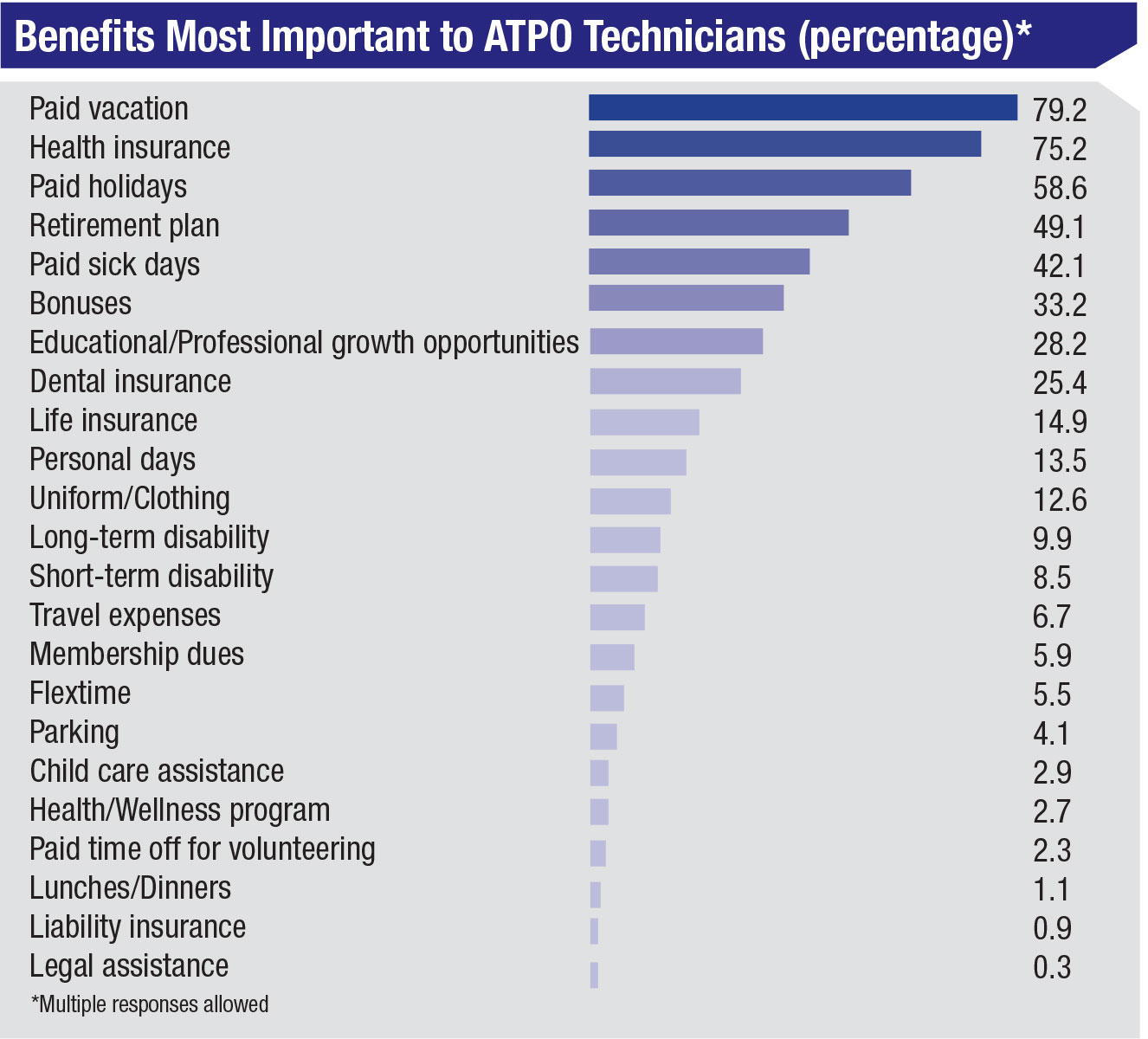 |
How to Keep a Tech
Whether a person is newly hired or has been with your practice for years, there are certain things you can do to help retain them.
• Create opportunities for growth. Practices need to help employees understand that they’re growing, even if they’re doing similar things, says Ms. Reitinger. “It seems to be a generational thing,” she says. “Today, applicants feel they need to move on to grow.”
By helping people take ownership for different aspects of their job, practices can improve retention. “When people are too much in a box, it can feel like a dead end,” Ms. Reitinger says. “If you’re good in the phone room, we’re not going to let you out because you’re so good! Instead, find out if they’d like to do something different and let them learn a new skill. The offices that are more willing to follow people through their progression of learning keep people a lot longer.”
• Check your on-boarding process. Ms. Wohl says a well-established on-boarding process can improve employee retention, especially during the first few years of employment. Having a coordinated, thoughtful training period with standards to meet enables an employee to begin with a strong footing. “Designate a specific person to do the training, not someone who just happened to be available that day,” she says. “Choose someone you think will do a great job so they’ll train the new person the way management wants them trained.
“You should have a formal onboarding checklist that includes all the job functions so you know training has been completed thoroughly,” Ms. Wohl continues. “This helps the new employees become confident more quickly than if it’s done in an disorganized fashion. The management team is responsible for preparing a current position description and on-boarding checklists so the expectations for new hires are clear to all.”
• Recognize a job well-done. Dr. Dewey finds that good technicians who take their time with patients make the day flow better and have improved his own patient interactions. “Ophthalmology is a peculiar field because we’re relying upon the patient to give us their own perspective on how things are working,” Dr. Dewey says. “It’s obviously very difficult to separate our own biases from what the patient is telling us. Finding a tech who can objectively listen to a patient’s very subjective issues is a challenge, so when you find individuals who can really help the patient with what they’re going through, and help them understand what needs to happen, you really need to make sure those employees are rewarded.”
• Take your charm pills. Mr. Pinto recommends treating your employees like your patients, or as if they were volunteers. “What would you do if you had a volunteer in your office?” he asks. “You might go to the break room and get them a cup of coffee. You might say at some point, ‘We really appreciate your being here. You mean a lot to us. Thanks for putting in the time.’”
Dr. Kershner agrees. “Techs don’t recognize their value based on how much they’re getting paid but by how well they’re treated,” he says. “They have to feel that they’re appreciated and respected and that you’re helping advance their skills.”
• Show them they’re making a difference. Dr. Jahnle says that most people in the medical assisting field want to help people. “They like the idea that a patient comes in and has a problem and they’re involved in helping the person,” he says. “So if you can show them that they’re actually helping people, I think that’s what makes them stay.”
Start Your Own Program
A 2016 qualitative case study found that establishing formal training programs was part of an important strategy for supplying a skilled, qualified ophthalmic workforce to meet the future demands of ophthalmic patient care.7 Likewise, a 2011 comparative analysis surveying ophthalmologists identified trained ophthalmic medical personnel as both a need and a means of increasing productivity.8
“There’s a tremendous lack of awareness of this profession by the public and people seeking a job,” Dr. Anderson says. She says that the shortage of degreed and certified technicians stems in part from the traditionally nonacademic nature of the job, since most employees can be trained on the job.
Dr. Jahnle says more training programs would benefit the ophthalmology community. “It’d be great if the ophthalmologists could work together,” he says. “Then everybody who graduates from the program could work in somebody’s office. But it’s hard to do that.”
The 30 ophthalmic technician programs in the United States are sprinkled among just 19 states and the District of Columbia. Only seven programs offer Associate degrees, and nine are still in the process of accreditation.2 North Carolina has five programs and Texas seven, but most states with programs have only one or two, which makes accessing these programs an additional obstacle.
“We need to encourage local ophthalmologists to start and support a training program,” Dr. Anderson says. “We need support by ophthalmologists at all levels for technicians—mentoring, compensation, education and training, certification and more.”
To help address the shortage, experts say you can express the need for trained technicians to local academic institutions, help develop a curriculum for schools that are interested, become a faculty member in a training program, help a school apply for accreditation and be ready to hire graduates when they come out.9 Your next technician could be easier to find than you think. REVIEW
1. Employment, unemployment, and openings, hires, and separations. Health care and social assistance sector. Bureau of Labor Statistics. https://www.bls.gov/iag/tgs/iag62.htm
2. Find a program. International Council of Accreditation for Allied Ophthalmic Education Programs. http://www.icaccreditation.org/find_a_program/find_a_program.html
3. Quick facts: Medical assistants. Occupational Outlook Handbook. Bureau of Labor Statistics. https://www.bls.gov/ooh/healthcare/medical-assistants.htm
4. IHS Markit. 2019 Update. The complexities of physician supply and demand: Projections from 2017 to 2032. Prepared for the Association of American Medical Colleges. Washington, DC: Association of American Medical Colleges. https://news.aamc.org/content/downloadable/209/
5. Woodworth Jr KE, Donshik PC, Ehlers WH, Pucel DJ, Anderson LD, Thompson NA. A comparative study of the impact of certified and noncertified ophthalmic medical personnel on practice quality and productivity. Eye & Contact Lens 2008;34:1:28-34.
6. Association of Technical Personnel in Ophthalmology. 2017 National Report: Salary and Benefits for Allied Ophthalmic Personnel. Executive Summary:3.
7. Astle W, Simms C, Anderson L. A workforce in crisis: A case study to expand allied ophthalmic personnel. Can J Ophthalmol 2016;51:4:288-293.
8. Astle W, El-Defrawy S, La Roche GR, et al. Survey on allied health personnel in Canadian ophthalmology: The scalpel for change. Can J Ophthalmol 2011;46:28-34.
9. Check list for initial letter of application. International Council of Accreditation. http://www.icaccreditation.org/pdf/CheckList.pdf




